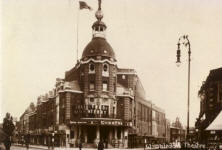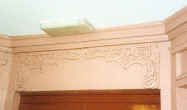1. The theatre and its Turkish baths

Photo: The Theatres Trust
Although there have been a few cases of cinemas opening in buildings which were originally built as Turkish baths,1 Wimbledon Theatre seems to have been the only theatre which had its own Turkish bath in the basement.2
The theatre was designed by Cecil Masey and Roy Young, with Frank J Jones. It was owned by J B Mulholland, under whose management it opened on 26 December 1910 with a pantomime, Jack and Jill. In addition to the theatre and Turkish baths, the building also included shops, an assembly hall, and two floors of offices.
Rear lobby of the theatre
Oriental style lintel over bath entrance
Very little appears to have been written about the Turkish baths when the theatre was opened. However, as the only entrance was through one of several doorways leading off a lobby within the theatre building, it is safe to assume that it was intended mainly for the benefit of the actors and theatre staff, perhaps to relax the former and de-stress the latter. Furthermore, the absence of a women's toilet indicates that it was intended for use only by the male actors and theatre staff.
Although this lobby had an entrance from the street—the door to the left of the Turkish bath entrance led upstairs to the assembly hall, and that to the right was a fire exit from the theatre Stalls—it is not clear whether the baths were ever open to members of the public. No mention is to be found in the local directories of the period; no mention has been found in newspaper advertisements for the theatre; neither did there seem to be any advertisements for the Turkish bath itself.
One local paper, describing the building prior to its opening, did note the existence of the Turkish bath but made no mention of who it was for. What did interest them was the use of the Turkish bath to augment the heating of the theatre.
There are Turkish baths on part of the site occupied by the theatre and a series of ducts from the hot rooms have been arranged connecting with gratings in the floors and walls of the theatre, so that in the event of the climate playing one of their sudden pranks with which it afflicts us, the temperature can be raised from 40 to 60 degrees in 15 minutes.3
Contemporary theatregoers must have hoped that the Turkish bath was empty of sweating bathers while the theatre temperature was being raised in this novel manner.
The Theatre closed in 1938, and the Turkish bath remained closed when the theatre re-opened after the war. It is, happily, still open and continues to provide a full programme of shows and live entertainment.


